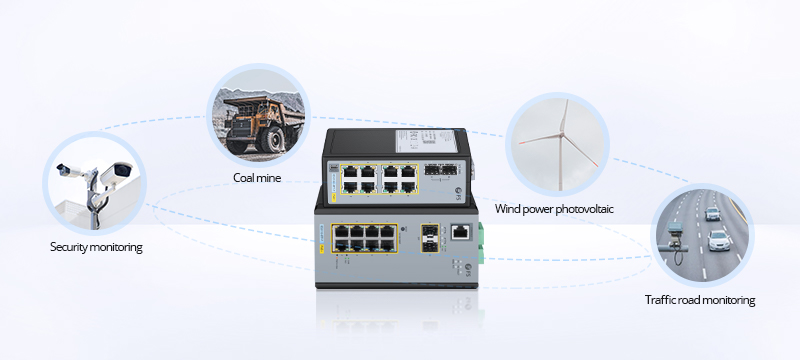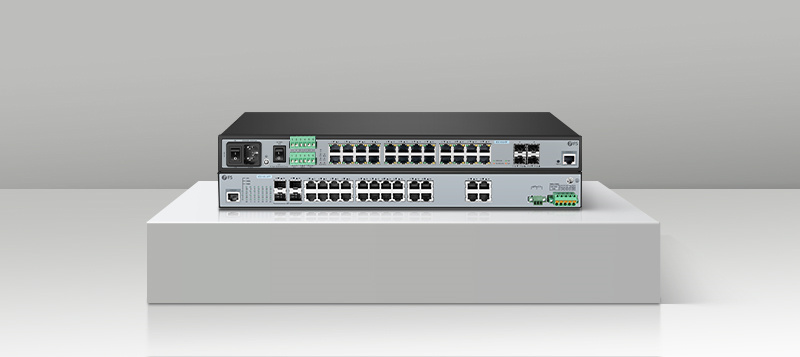In the dynamic landscape of industrial networking, the role of Industrial Ethernet switches stands out as a cornerstone for seamless data transmission in challenging environments. This article explores the myriad advantages of these switches and delves into the diverse types that cater to specific industrial needs.
1.The Advantages of Industrial Ethernet Switches
• Versatility in Challenging Temperature Environments:
Engineered for resilience in demanding conditions, Industrial Ethernet switches prioritize adaptability to varying temperatures. Employing pleated metal casings for swift heat dissipation and advanced protection, these switches excel in flawless operation within the temperature range of -40°C to 85°C. This versatility positions them as ideal solutions for settings characterized by intricate temperature and humidity fluctuations.
• Exceptional Immunity to Electrical Interference:
Navigating the complexities of industrial networking, Industrial-grade switches triumph over the challenge of electrical noise. Demonstrating robust anti-interference performance, they thrive in harsh electromagnetic environments. Furthermore, these switches feature superior protection against lightning, waterproofing, corrosion, shocks, and static, ensuring continuous and secure data transmission.
• Innovative Redundancy in Power Supply:
Acknowledging the pivotal role of power supply in switch functionality, Industrial switches incorporate a dual power supply redundancy design. This innovative approach minimizes the risk of power failure, guaranteeing a stable and reliable operation. Additionally, the system design facilitates the utilization of hot-swappable media modules (RJ45, SFP, PoE) and power units, providing unparalleled flexibility and availability, particularly critical for continuity-sensitive operations.
• Swift Ring Network Deployment and Rapid Redundancy:
Industrial switches demonstrate a prowess for establishing swift redundant networks, crafting reliable industrial networks with an impressive self-healing time of less than 50 milliseconds. This swift recovery ensures a prompt response in the event of a disrupted data pathway, effectively mitigating potential damages in scenarios such as production line shutdowns or abnormal power plant operations.
• Proven Durability and Extended Operational Lifespan:
The robustness of Industrial Ethernet switches underscores their reliance on industrial-grade solutions, spanning from shell material to companion components. In environments where downtime costs carry significant weight, these switches offer heightened reliability and an extended service life. Unlike their commercial counterparts with a typical life cycle of 3 to 5 years, Industrial Ethernet switches showcase a capability to consistently operate for a period of 10 years or more.

2.Different Types of Industrial Switches
In the realm of networking solutions, industrial Ethernet switches stand out as versatile tools, adapting to the unique demands of industrial environments. Let's delve into the distinct types that cater to specific needs, highlighting their features and applications.
• Managed vs. Unmanaged Industrial Switches
Managed industrial switches empower users by providing control over LAN settings, allowing seamless management, configuration, and monitoring of industrial Ethernet LAN traffic. Conversely, unmanaged switches offer simplicity with a plug-and-play approach, requiring no setup for immediate network connectivity.
• Industrial PoE vs. Non-PoE Switches
PoE switches, incorporating PoE passthrough, not only transmit network data but also deliver power through Ethernet cables. On the other hand, non-PoE switches lack this power supply capability. Both industrial PoE and non-PoE switches boast an industrial-grade design, ensuring resilience against moisture, dust, dirt, oil, and other potential damaging substances.
• Din-rail, Rackmount, and Wall-mount Switches
Industrial Ethernet switches provide flexibility in mounting options, offering DIN-rail switches, wall-mount switches, and rackmount switches. This versatility enables precise installation, whether on a standard DIN rail, within the control cabinet, or externally. These purpose-designed switches facilitate easy installation, optimizing cabinet space utilization in challenging industrial environments.
3.Industrial Ethernet Switches vs. Regular Ethernet Switches
Next, we delve deeper into the specific differentiators between switches, here is the most common comparison between industrial Ethernet switches and regular Ethernet switches.
|
Features |
Industrial Ethernet Switches |
Regular Ethernet Switches |
| Appearance | Rugged and robust exterior, often with integrated metal shells | Lightweight design, commonly with plastic or metal shells, optimized for office or home environments |
| Climatic Environment | Endures wide range of climatic conditions, suitable for outdoor and non-climate-controlled environments | Suited for stable and controlled indoor settings, may struggle in extreme temperatures or humidity levels |
| Electromagnetic Environment | Designed to withstand electromagnetic interference in industrial environments, with shielding for signal disruption prevention | May not offer the same level of protection against electromagnetic interference |
| Operating Voltage | Supports a wider range of operating voltages to accommodate variations in industrial power supplies | Typically adheres to standard voltage levels found in office or home environments |
| Power Supply Design | Often equipped with redundant power supply options for continuous operation in case of power failures, crucial for critical industrial applications | Typically relies on a single power source |
| Installation Method | Offers flexible installation methods like wall mounting, rack mounting, and DIN rail mounting to suit diverse industrial setups | Typically designed for tabletop or rack installation in conventional office settings |
| Cooling Method | Employs advanced cooling mechanisms such as fanless designs or enhanced airflow systems to manage heat effectively | May utilize standard cooling methods, often relying on internal fans |
| Service Life | Engineered for extended service life and long-term reliability to withstand the rigors of industrial applications | May have shorter service life expectations due to optimized designs for more controlled environments |
In conclusion, the advantages and diverse types of industrial Ethernet switches underscore their pivotal role in establishing robust and reliable industrial networks. As industries continue to evolve, the significance of these switches in fostering automation, connectivity, and data security becomes increasingly evident.
Post time: Dec-19-2023




